University Report: Partnership and Relationship of Organizations
VerifiedAdded on 2021/05/30
|6
|2038
|39
Report
AI Summary
This report delves into the critical aspects of partnerships and relationships between organizations, emphasizing the significance of collaboration in addressing sustainability challenges within the agriculture business. It highlights the benefits of collaborative efforts, including shared vision, stakeholder coordination, and the development of new business models. The report stresses the importance of assessing organizational missions and visions before entering partnerships, as well as the impact of leadership styles and emotional intelligence on collaborative success. It addresses risk assessment, relevant legislations in Australia, and the value of strategic partnerships and data collection. Furthermore, it explores strategies for improving partnerships through combined efforts, effective management, and the use of PESTEL analysis to understand the external environment. The conclusion underscores the importance of robust risk management, emotional intelligence, and financial commitment for successful organizational partnerships.
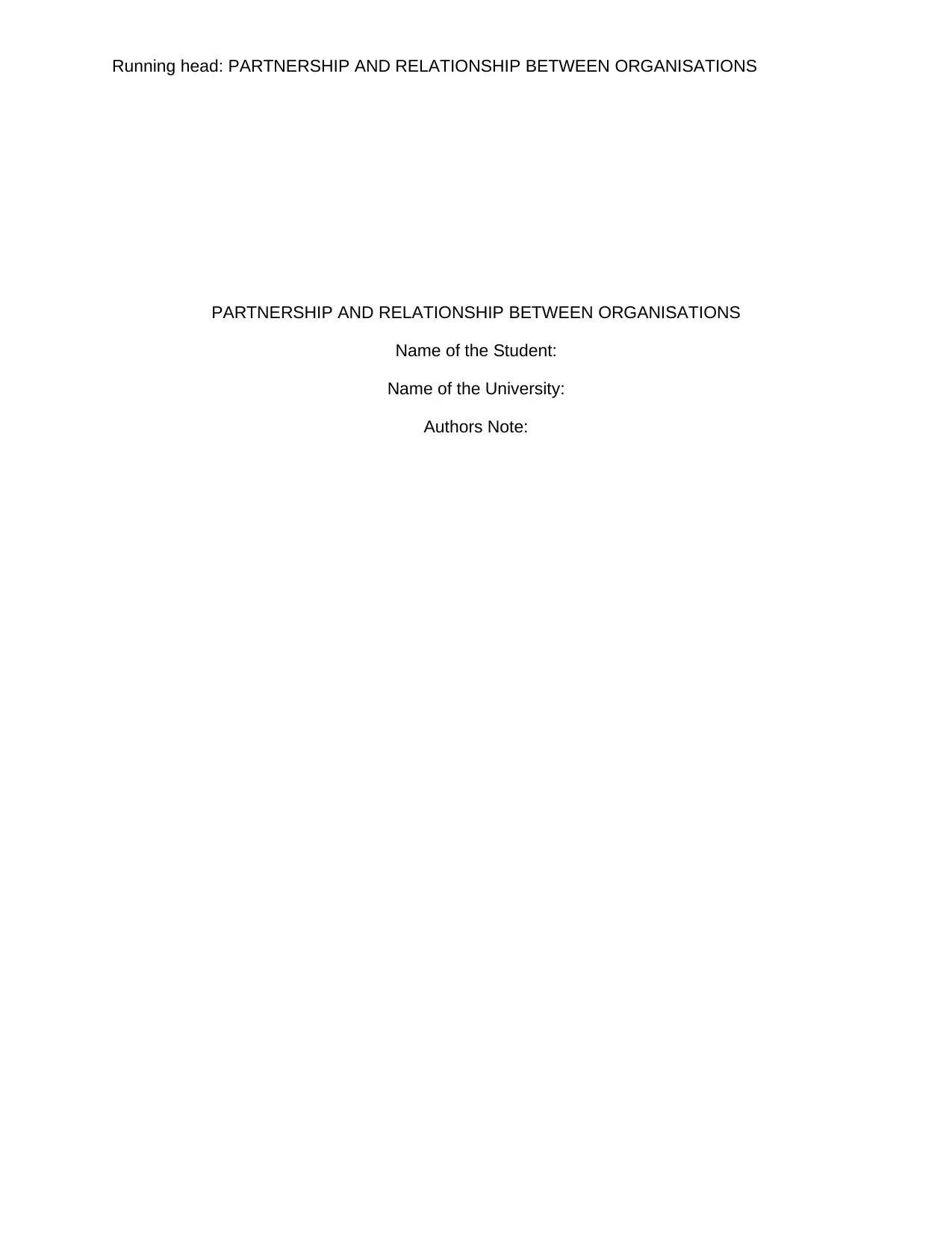
Running head: PARTNERSHIP AND RELATIONSHIP BETWEEN ORGANISATIONS
PARTNERSHIP AND RELATIONSHIP BETWEEN ORGANISATIONS
Name of the Student:
Name of the University:
Authors Note:
PARTNERSHIP AND RELATIONSHIP BETWEEN ORGANISATIONS
Name of the Student:
Name of the University:
Authors Note:
Paraphrase This Document
Need a fresh take? Get an instant paraphrase of this document with our AI Paraphraser
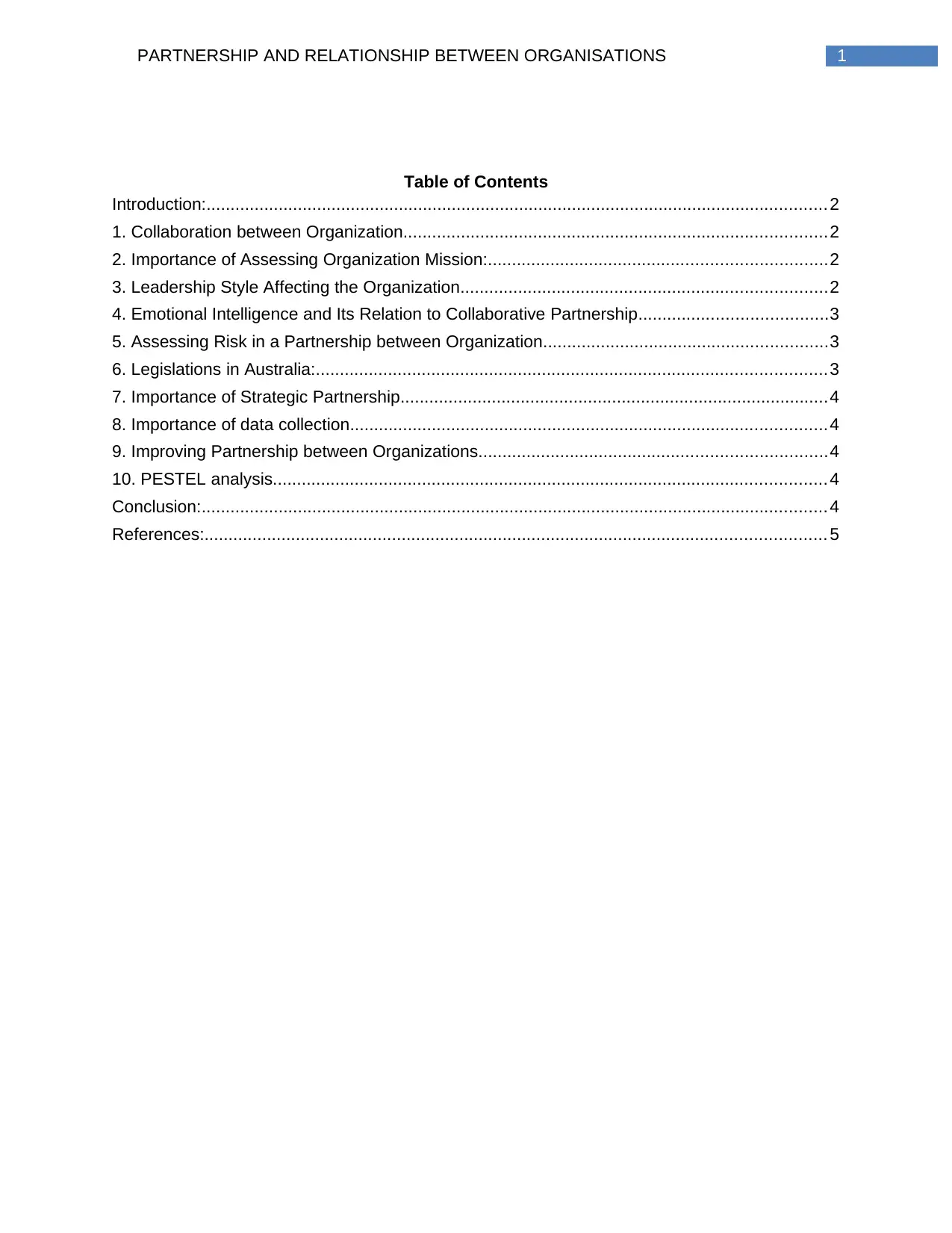
1PARTNERSHIP AND RELATIONSHIP BETWEEN ORGANISATIONS
Table of Contents
Introduction:................................................................................................................................. 2
1. Collaboration between Organization........................................................................................2
2. Importance of Assessing Organization Mission:......................................................................2
3. Leadership Style Affecting the Organization............................................................................2
4. Emotional Intelligence and Its Relation to Collaborative Partnership.......................................3
5. Assessing Risk in a Partnership between Organization...........................................................3
6. Legislations in Australia:..........................................................................................................3
7. Importance of Strategic Partnership.........................................................................................4
8. Importance of data collection...................................................................................................4
9. Improving Partnership between Organizations........................................................................4
10. PESTEL analysis................................................................................................................... 4
Conclusion:.................................................................................................................................. 4
References:................................................................................................................................. 5
Table of Contents
Introduction:................................................................................................................................. 2
1. Collaboration between Organization........................................................................................2
2. Importance of Assessing Organization Mission:......................................................................2
3. Leadership Style Affecting the Organization............................................................................2
4. Emotional Intelligence and Its Relation to Collaborative Partnership.......................................3
5. Assessing Risk in a Partnership between Organization...........................................................3
6. Legislations in Australia:..........................................................................................................3
7. Importance of Strategic Partnership.........................................................................................4
8. Importance of data collection...................................................................................................4
9. Improving Partnership between Organizations........................................................................4
10. PESTEL analysis................................................................................................................... 4
Conclusion:.................................................................................................................................. 4
References:................................................................................................................................. 5
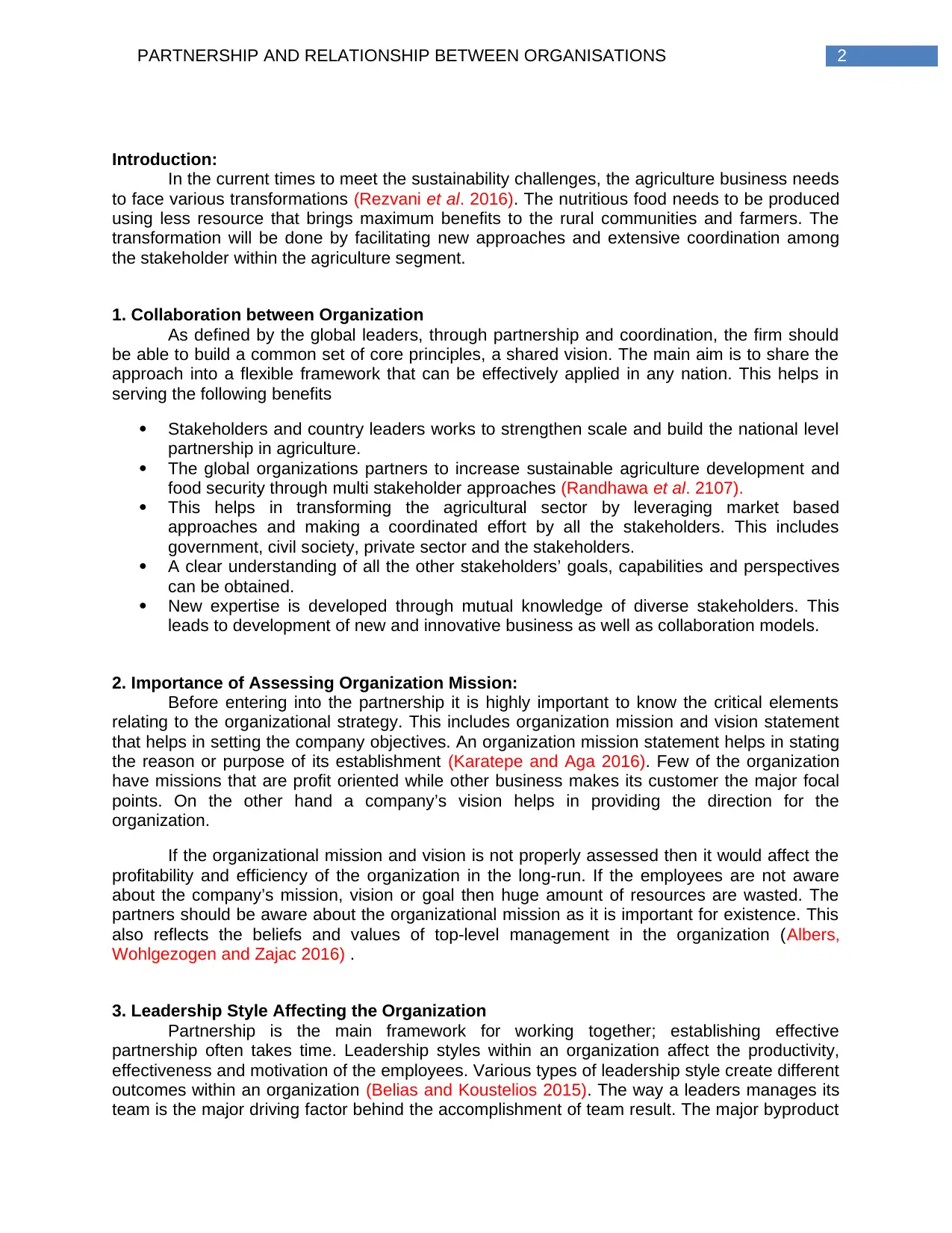
2PARTNERSHIP AND RELATIONSHIP BETWEEN ORGANISATIONS
Introduction:
In the current times to meet the sustainability challenges, the agriculture business needs
to face various transformations (Rezvani et al. 2016). The nutritious food needs to be produced
using less resource that brings maximum benefits to the rural communities and farmers. The
transformation will be done by facilitating new approaches and extensive coordination among
the stakeholder within the agriculture segment.
1. Collaboration between Organization
As defined by the global leaders, through partnership and coordination, the firm should
be able to build a common set of core principles, a shared vision. The main aim is to share the
approach into a flexible framework that can be effectively applied in any nation. This helps in
serving the following benefits
Stakeholders and country leaders works to strengthen scale and build the national level
partnership in agriculture.
The global organizations partners to increase sustainable agriculture development and
food security through multi stakeholder approaches (Randhawa et al. 2107).
This helps in transforming the agricultural sector by leveraging market based
approaches and making a coordinated effort by all the stakeholders. This includes
government, civil society, private sector and the stakeholders.
A clear understanding of all the other stakeholders’ goals, capabilities and perspectives
can be obtained.
New expertise is developed through mutual knowledge of diverse stakeholders. This
leads to development of new and innovative business as well as collaboration models.
2. Importance of Assessing Organization Mission:
Before entering into the partnership it is highly important to know the critical elements
relating to the organizational strategy. This includes organization mission and vision statement
that helps in setting the company objectives. An organization mission statement helps in stating
the reason or purpose of its establishment (Karatepe and Aga 2016). Few of the organization
have missions that are profit oriented while other business makes its customer the major focal
points. On the other hand a company’s vision helps in providing the direction for the
organization.
If the organizational mission and vision is not properly assessed then it would affect the
profitability and efficiency of the organization in the long-run. If the employees are not aware
about the company’s mission, vision or goal then huge amount of resources are wasted. The
partners should be aware about the organizational mission as it is important for existence. This
also reflects the beliefs and values of top-level management in the organization (Albers,
Wohlgezogen and Zajac 2016) .
3. Leadership Style Affecting the Organization
Partnership is the main framework for working together; establishing effective
partnership often takes time. Leadership styles within an organization affect the productivity,
effectiveness and motivation of the employees. Various types of leadership style create different
outcomes within an organization (Belias and Koustelios 2015). The way a leaders manages its
team is the major driving factor behind the accomplishment of team result. The major byproduct
Introduction:
In the current times to meet the sustainability challenges, the agriculture business needs
to face various transformations (Rezvani et al. 2016). The nutritious food needs to be produced
using less resource that brings maximum benefits to the rural communities and farmers. The
transformation will be done by facilitating new approaches and extensive coordination among
the stakeholder within the agriculture segment.
1. Collaboration between Organization
As defined by the global leaders, through partnership and coordination, the firm should
be able to build a common set of core principles, a shared vision. The main aim is to share the
approach into a flexible framework that can be effectively applied in any nation. This helps in
serving the following benefits
Stakeholders and country leaders works to strengthen scale and build the national level
partnership in agriculture.
The global organizations partners to increase sustainable agriculture development and
food security through multi stakeholder approaches (Randhawa et al. 2107).
This helps in transforming the agricultural sector by leveraging market based
approaches and making a coordinated effort by all the stakeholders. This includes
government, civil society, private sector and the stakeholders.
A clear understanding of all the other stakeholders’ goals, capabilities and perspectives
can be obtained.
New expertise is developed through mutual knowledge of diverse stakeholders. This
leads to development of new and innovative business as well as collaboration models.
2. Importance of Assessing Organization Mission:
Before entering into the partnership it is highly important to know the critical elements
relating to the organizational strategy. This includes organization mission and vision statement
that helps in setting the company objectives. An organization mission statement helps in stating
the reason or purpose of its establishment (Karatepe and Aga 2016). Few of the organization
have missions that are profit oriented while other business makes its customer the major focal
points. On the other hand a company’s vision helps in providing the direction for the
organization.
If the organizational mission and vision is not properly assessed then it would affect the
profitability and efficiency of the organization in the long-run. If the employees are not aware
about the company’s mission, vision or goal then huge amount of resources are wasted. The
partners should be aware about the organizational mission as it is important for existence. This
also reflects the beliefs and values of top-level management in the organization (Albers,
Wohlgezogen and Zajac 2016) .
3. Leadership Style Affecting the Organization
Partnership is the main framework for working together; establishing effective
partnership often takes time. Leadership styles within an organization affect the productivity,
effectiveness and motivation of the employees. Various types of leadership style create different
outcomes within an organization (Belias and Koustelios 2015). The way a leaders manages its
team is the major driving factor behind the accomplishment of team result. The major byproduct
⊘ This is a preview!⊘
Do you want full access?
Subscribe today to unlock all pages.

Trusted by 1+ million students worldwide
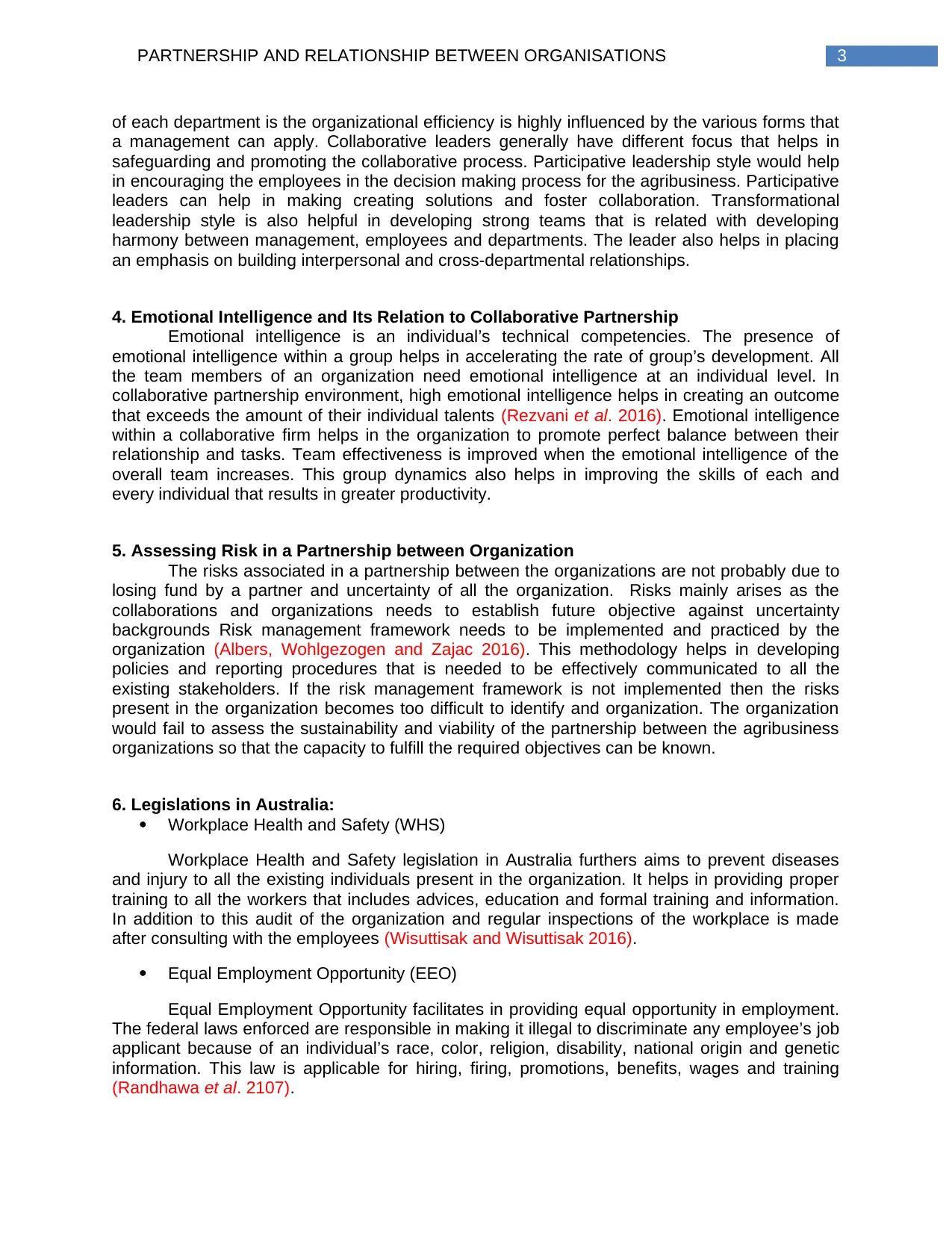
3PARTNERSHIP AND RELATIONSHIP BETWEEN ORGANISATIONS
of each department is the organizational efficiency is highly influenced by the various forms that
a management can apply. Collaborative leaders generally have different focus that helps in
safeguarding and promoting the collaborative process. Participative leadership style would help
in encouraging the employees in the decision making process for the agribusiness. Participative
leaders can help in making creating solutions and foster collaboration. Transformational
leadership style is also helpful in developing strong teams that is related with developing
harmony between management, employees and departments. The leader also helps in placing
an emphasis on building interpersonal and cross-departmental relationships.
4. Emotional Intelligence and Its Relation to Collaborative Partnership
Emotional intelligence is an individual’s technical competencies. The presence of
emotional intelligence within a group helps in accelerating the rate of group’s development. All
the team members of an organization need emotional intelligence at an individual level. In
collaborative partnership environment, high emotional intelligence helps in creating an outcome
that exceeds the amount of their individual talents (Rezvani et al. 2016). Emotional intelligence
within a collaborative firm helps in the organization to promote perfect balance between their
relationship and tasks. Team effectiveness is improved when the emotional intelligence of the
overall team increases. This group dynamics also helps in improving the skills of each and
every individual that results in greater productivity.
5. Assessing Risk in a Partnership between Organization
The risks associated in a partnership between the organizations are not probably due to
losing fund by a partner and uncertainty of all the organization. Risks mainly arises as the
collaborations and organizations needs to establish future objective against uncertainty
backgrounds Risk management framework needs to be implemented and practiced by the
organization (Albers, Wohlgezogen and Zajac 2016). This methodology helps in developing
policies and reporting procedures that is needed to be effectively communicated to all the
existing stakeholders. If the risk management framework is not implemented then the risks
present in the organization becomes too difficult to identify and organization. The organization
would fail to assess the sustainability and viability of the partnership between the agribusiness
organizations so that the capacity to fulfill the required objectives can be known.
6. Legislations in Australia:
Workplace Health and Safety (WHS)
Workplace Health and Safety legislation in Australia furthers aims to prevent diseases
and injury to all the existing individuals present in the organization. It helps in providing proper
training to all the workers that includes advices, education and formal training and information.
In addition to this audit of the organization and regular inspections of the workplace is made
after consulting with the employees (Wisuttisak and Wisuttisak 2016).
Equal Employment Opportunity (EEO)
Equal Employment Opportunity facilitates in providing equal opportunity in employment.
The federal laws enforced are responsible in making it illegal to discriminate any employee’s job
applicant because of an individual’s race, color, religion, disability, national origin and genetic
information. This law is applicable for hiring, firing, promotions, benefits, wages and training
(Randhawa et al. 2107).
of each department is the organizational efficiency is highly influenced by the various forms that
a management can apply. Collaborative leaders generally have different focus that helps in
safeguarding and promoting the collaborative process. Participative leadership style would help
in encouraging the employees in the decision making process for the agribusiness. Participative
leaders can help in making creating solutions and foster collaboration. Transformational
leadership style is also helpful in developing strong teams that is related with developing
harmony between management, employees and departments. The leader also helps in placing
an emphasis on building interpersonal and cross-departmental relationships.
4. Emotional Intelligence and Its Relation to Collaborative Partnership
Emotional intelligence is an individual’s technical competencies. The presence of
emotional intelligence within a group helps in accelerating the rate of group’s development. All
the team members of an organization need emotional intelligence at an individual level. In
collaborative partnership environment, high emotional intelligence helps in creating an outcome
that exceeds the amount of their individual talents (Rezvani et al. 2016). Emotional intelligence
within a collaborative firm helps in the organization to promote perfect balance between their
relationship and tasks. Team effectiveness is improved when the emotional intelligence of the
overall team increases. This group dynamics also helps in improving the skills of each and
every individual that results in greater productivity.
5. Assessing Risk in a Partnership between Organization
The risks associated in a partnership between the organizations are not probably due to
losing fund by a partner and uncertainty of all the organization. Risks mainly arises as the
collaborations and organizations needs to establish future objective against uncertainty
backgrounds Risk management framework needs to be implemented and practiced by the
organization (Albers, Wohlgezogen and Zajac 2016). This methodology helps in developing
policies and reporting procedures that is needed to be effectively communicated to all the
existing stakeholders. If the risk management framework is not implemented then the risks
present in the organization becomes too difficult to identify and organization. The organization
would fail to assess the sustainability and viability of the partnership between the agribusiness
organizations so that the capacity to fulfill the required objectives can be known.
6. Legislations in Australia:
Workplace Health and Safety (WHS)
Workplace Health and Safety legislation in Australia furthers aims to prevent diseases
and injury to all the existing individuals present in the organization. It helps in providing proper
training to all the workers that includes advices, education and formal training and information.
In addition to this audit of the organization and regular inspections of the workplace is made
after consulting with the employees (Wisuttisak and Wisuttisak 2016).
Equal Employment Opportunity (EEO)
Equal Employment Opportunity facilitates in providing equal opportunity in employment.
The federal laws enforced are responsible in making it illegal to discriminate any employee’s job
applicant because of an individual’s race, color, religion, disability, national origin and genetic
information. This law is applicable for hiring, firing, promotions, benefits, wages and training
(Randhawa et al. 2107).
Paraphrase This Document
Need a fresh take? Get an instant paraphrase of this document with our AI Paraphraser
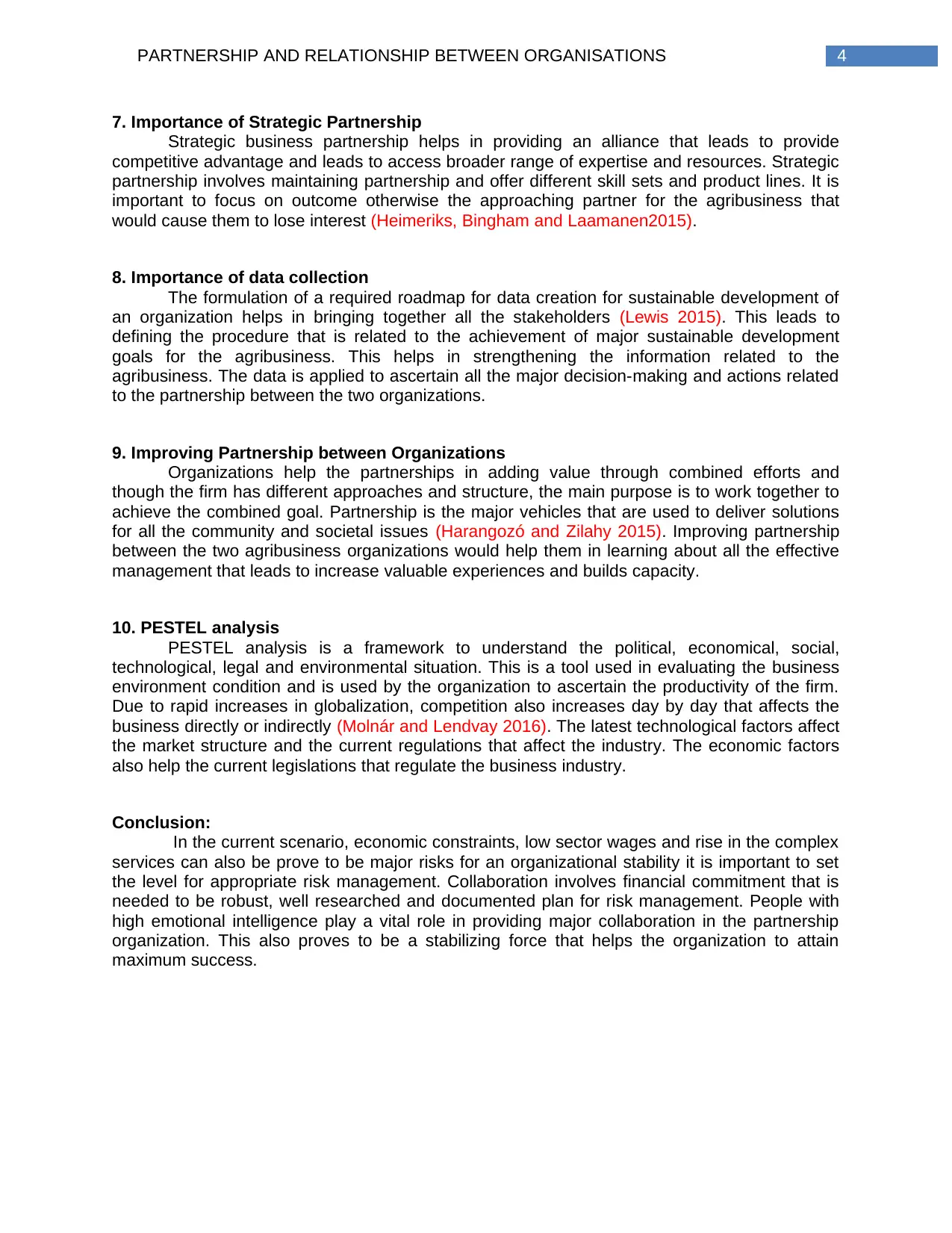
4PARTNERSHIP AND RELATIONSHIP BETWEEN ORGANISATIONS
7. Importance of Strategic Partnership
Strategic business partnership helps in providing an alliance that leads to provide
competitive advantage and leads to access broader range of expertise and resources. Strategic
partnership involves maintaining partnership and offer different skill sets and product lines. It is
important to focus on outcome otherwise the approaching partner for the agribusiness that
would cause them to lose interest (Heimeriks, Bingham and Laamanen2015).
8. Importance of data collection
The formulation of a required roadmap for data creation for sustainable development of
an organization helps in bringing together all the stakeholders (Lewis 2015). This leads to
defining the procedure that is related to the achievement of major sustainable development
goals for the agribusiness. This helps in strengthening the information related to the
agribusiness. The data is applied to ascertain all the major decision-making and actions related
to the partnership between the two organizations.
9. Improving Partnership between Organizations
Organizations help the partnerships in adding value through combined efforts and
though the firm has different approaches and structure, the main purpose is to work together to
achieve the combined goal. Partnership is the major vehicles that are used to deliver solutions
for all the community and societal issues (Harangozó and Zilahy 2015). Improving partnership
between the two agribusiness organizations would help them in learning about all the effective
management that leads to increase valuable experiences and builds capacity.
10. PESTEL analysis
PESTEL analysis is a framework to understand the political, economical, social,
technological, legal and environmental situation. This is a tool used in evaluating the business
environment condition and is used by the organization to ascertain the productivity of the firm.
Due to rapid increases in globalization, competition also increases day by day that affects the
business directly or indirectly (Molnár and Lendvay 2016). The latest technological factors affect
the market structure and the current regulations that affect the industry. The economic factors
also help the current legislations that regulate the business industry.
Conclusion:
In the current scenario, economic constraints, low sector wages and rise in the complex
services can also be prove to be major risks for an organizational stability it is important to set
the level for appropriate risk management. Collaboration involves financial commitment that is
needed to be robust, well researched and documented plan for risk management. People with
high emotional intelligence play a vital role in providing major collaboration in the partnership
organization. This also proves to be a stabilizing force that helps the organization to attain
maximum success.
7. Importance of Strategic Partnership
Strategic business partnership helps in providing an alliance that leads to provide
competitive advantage and leads to access broader range of expertise and resources. Strategic
partnership involves maintaining partnership and offer different skill sets and product lines. It is
important to focus on outcome otherwise the approaching partner for the agribusiness that
would cause them to lose interest (Heimeriks, Bingham and Laamanen2015).
8. Importance of data collection
The formulation of a required roadmap for data creation for sustainable development of
an organization helps in bringing together all the stakeholders (Lewis 2015). This leads to
defining the procedure that is related to the achievement of major sustainable development
goals for the agribusiness. This helps in strengthening the information related to the
agribusiness. The data is applied to ascertain all the major decision-making and actions related
to the partnership between the two organizations.
9. Improving Partnership between Organizations
Organizations help the partnerships in adding value through combined efforts and
though the firm has different approaches and structure, the main purpose is to work together to
achieve the combined goal. Partnership is the major vehicles that are used to deliver solutions
for all the community and societal issues (Harangozó and Zilahy 2015). Improving partnership
between the two agribusiness organizations would help them in learning about all the effective
management that leads to increase valuable experiences and builds capacity.
10. PESTEL analysis
PESTEL analysis is a framework to understand the political, economical, social,
technological, legal and environmental situation. This is a tool used in evaluating the business
environment condition and is used by the organization to ascertain the productivity of the firm.
Due to rapid increases in globalization, competition also increases day by day that affects the
business directly or indirectly (Molnár and Lendvay 2016). The latest technological factors affect
the market structure and the current regulations that affect the industry. The economic factors
also help the current legislations that regulate the business industry.
Conclusion:
In the current scenario, economic constraints, low sector wages and rise in the complex
services can also be prove to be major risks for an organizational stability it is important to set
the level for appropriate risk management. Collaboration involves financial commitment that is
needed to be robust, well researched and documented plan for risk management. People with
high emotional intelligence play a vital role in providing major collaboration in the partnership
organization. This also proves to be a stabilizing force that helps the organization to attain
maximum success.
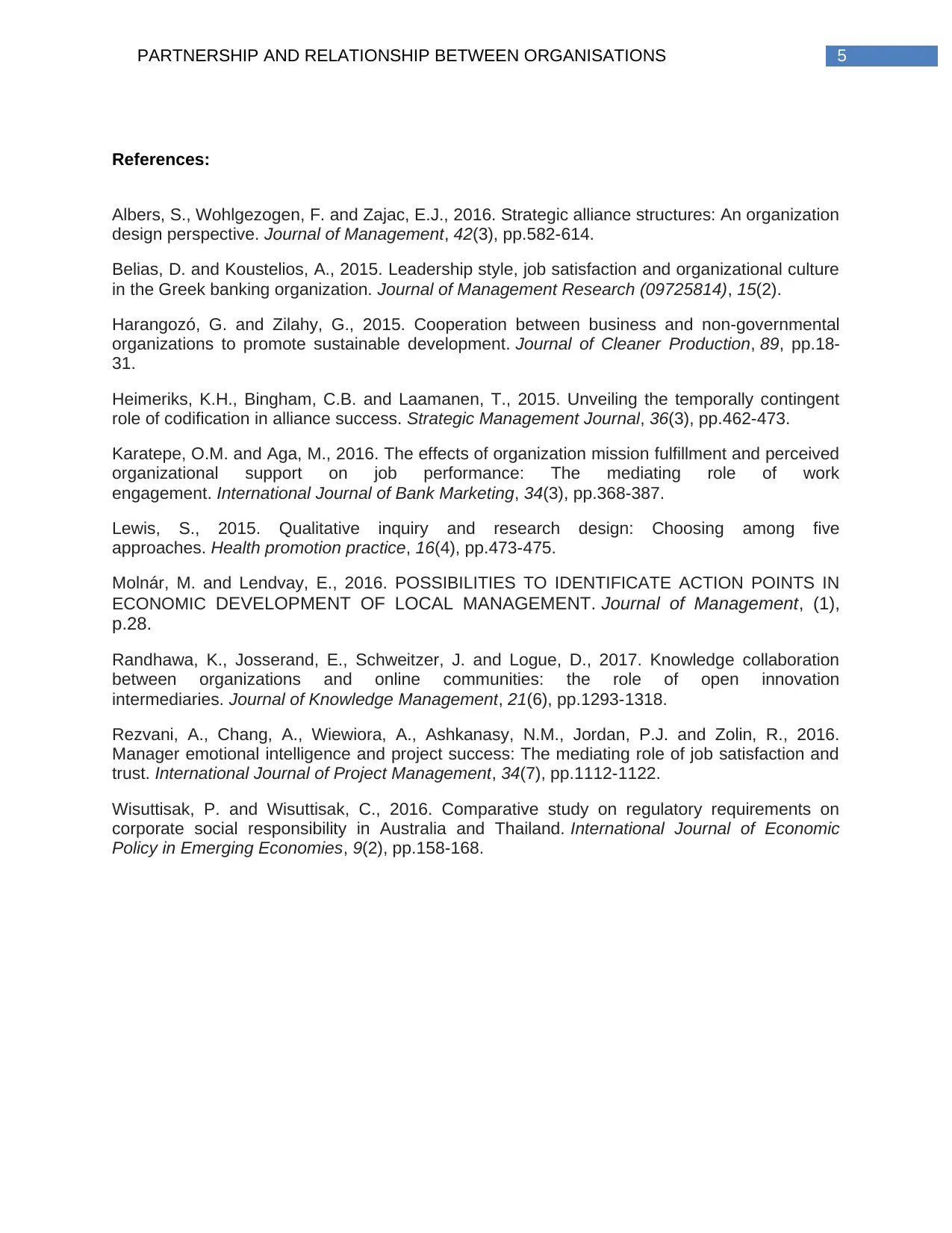
5PARTNERSHIP AND RELATIONSHIP BETWEEN ORGANISATIONS
References:
Albers, S., Wohlgezogen, F. and Zajac, E.J., 2016. Strategic alliance structures: An organization
design perspective. Journal of Management, 42(3), pp.582-614.
Belias, D. and Koustelios, A., 2015. Leadership style, job satisfaction and organizational culture
in the Greek banking organization. Journal of Management Research (09725814), 15(2).
Harangozó, G. and Zilahy, G., 2015. Cooperation between business and non-governmental
organizations to promote sustainable development. Journal of Cleaner Production, 89, pp.18-
31.
Heimeriks, K.H., Bingham, C.B. and Laamanen, T., 2015. Unveiling the temporally contingent
role of codification in alliance success. Strategic Management Journal, 36(3), pp.462-473.
Karatepe, O.M. and Aga, M., 2016. The effects of organization mission fulfillment and perceived
organizational support on job performance: The mediating role of work
engagement. International Journal of Bank Marketing, 34(3), pp.368-387.
Lewis, S., 2015. Qualitative inquiry and research design: Choosing among five
approaches. Health promotion practice, 16(4), pp.473-475.
Molnár, M. and Lendvay, E., 2016. POSSIBILITIES TO IDENTIFICATE ACTION POINTS IN
ECONOMIC DEVELOPMENT OF LOCAL MANAGEMENT. Journal of Management, (1),
p.28.
Randhawa, K., Josserand, E., Schweitzer, J. and Logue, D., 2017. Knowledge collaboration
between organizations and online communities: the role of open innovation
intermediaries. Journal of Knowledge Management, 21(6), pp.1293-1318.
Rezvani, A., Chang, A., Wiewiora, A., Ashkanasy, N.M., Jordan, P.J. and Zolin, R., 2016.
Manager emotional intelligence and project success: The mediating role of job satisfaction and
trust. International Journal of Project Management, 34(7), pp.1112-1122.
Wisuttisak, P. and Wisuttisak, C., 2016. Comparative study on regulatory requirements on
corporate social responsibility in Australia and Thailand. International Journal of Economic
Policy in Emerging Economies, 9(2), pp.158-168.
References:
Albers, S., Wohlgezogen, F. and Zajac, E.J., 2016. Strategic alliance structures: An organization
design perspective. Journal of Management, 42(3), pp.582-614.
Belias, D. and Koustelios, A., 2015. Leadership style, job satisfaction and organizational culture
in the Greek banking organization. Journal of Management Research (09725814), 15(2).
Harangozó, G. and Zilahy, G., 2015. Cooperation between business and non-governmental
organizations to promote sustainable development. Journal of Cleaner Production, 89, pp.18-
31.
Heimeriks, K.H., Bingham, C.B. and Laamanen, T., 2015. Unveiling the temporally contingent
role of codification in alliance success. Strategic Management Journal, 36(3), pp.462-473.
Karatepe, O.M. and Aga, M., 2016. The effects of organization mission fulfillment and perceived
organizational support on job performance: The mediating role of work
engagement. International Journal of Bank Marketing, 34(3), pp.368-387.
Lewis, S., 2015. Qualitative inquiry and research design: Choosing among five
approaches. Health promotion practice, 16(4), pp.473-475.
Molnár, M. and Lendvay, E., 2016. POSSIBILITIES TO IDENTIFICATE ACTION POINTS IN
ECONOMIC DEVELOPMENT OF LOCAL MANAGEMENT. Journal of Management, (1),
p.28.
Randhawa, K., Josserand, E., Schweitzer, J. and Logue, D., 2017. Knowledge collaboration
between organizations and online communities: the role of open innovation
intermediaries. Journal of Knowledge Management, 21(6), pp.1293-1318.
Rezvani, A., Chang, A., Wiewiora, A., Ashkanasy, N.M., Jordan, P.J. and Zolin, R., 2016.
Manager emotional intelligence and project success: The mediating role of job satisfaction and
trust. International Journal of Project Management, 34(7), pp.1112-1122.
Wisuttisak, P. and Wisuttisak, C., 2016. Comparative study on regulatory requirements on
corporate social responsibility in Australia and Thailand. International Journal of Economic
Policy in Emerging Economies, 9(2), pp.158-168.
⊘ This is a preview!⊘
Do you want full access?
Subscribe today to unlock all pages.

Trusted by 1+ million students worldwide
1 out of 6
Related Documents
Your All-in-One AI-Powered Toolkit for Academic Success.
+13062052269
info@desklib.com
Available 24*7 on WhatsApp / Email
![[object Object]](/_next/static/media/star-bottom.7253800d.svg)
Unlock your academic potential
Copyright © 2020–2025 A2Z Services. All Rights Reserved. Developed and managed by ZUCOL.





